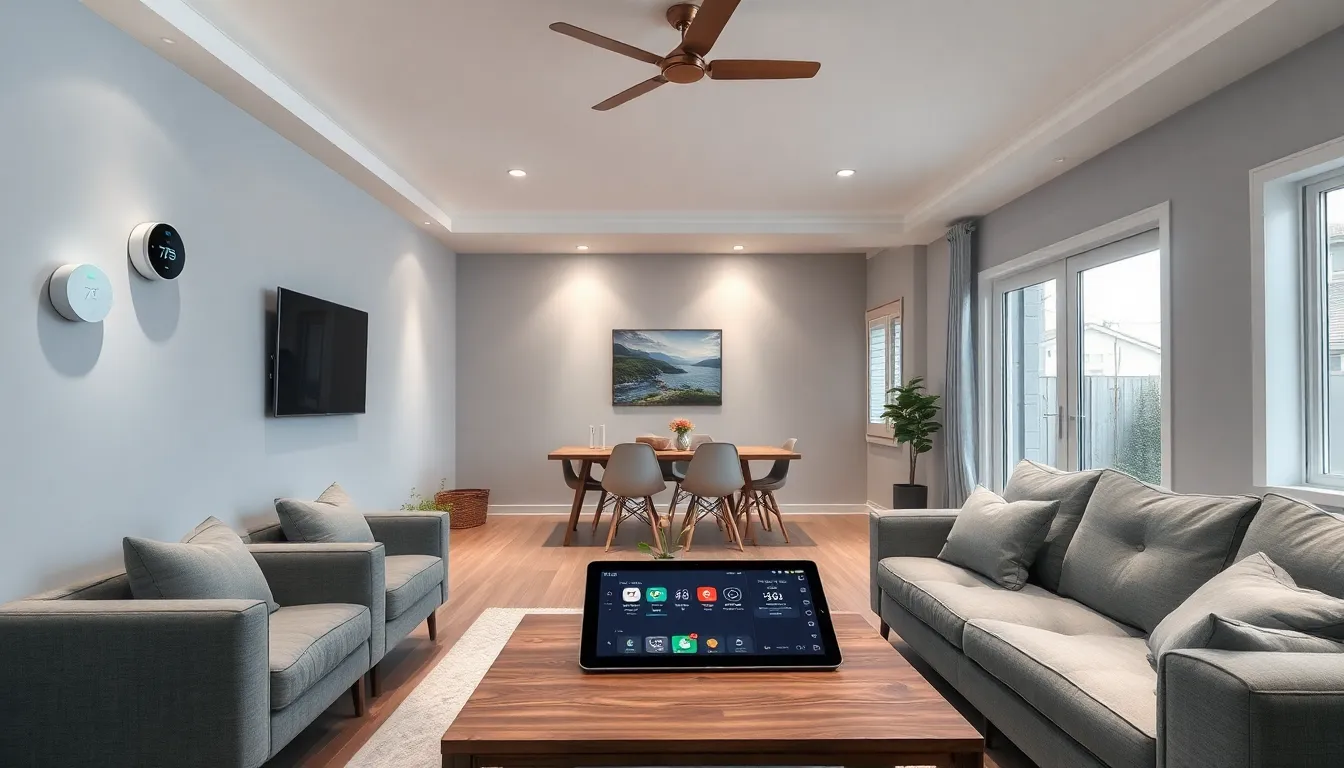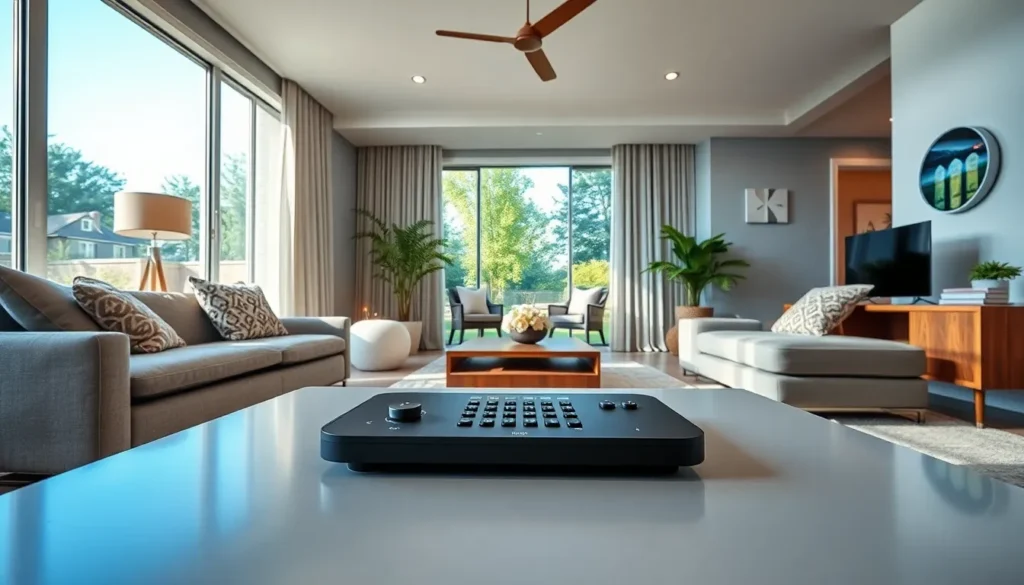Table of Contents
ToggleHome automation systems are revolutionizing the way people interact with their living spaces. With smart technology at their fingertips, homeowners can now control lighting, security, and even appliances from their smartphones. This shift not only enhances convenience but also contributes to energy efficiency and improved security.
As technology continues to evolve, the possibilities for home automation expand. From voice-activated assistants to automated climate control, these systems offer a seamless blend of comfort and functionality. Embracing home automation isn’t just about keeping up with trends; it’s about creating a smarter, more efficient home that adapts to individual lifestyles.
Overview of Home Automation Systems
Home automation systems integrate various technologies to enhance control over home devices. These systems facilitate the management of lighting, security, climate, and appliances from a centralized hub or mobile device. They utilize wireless communication protocols such as Wi-Fi, Zigbee, and Z-Wave to connect devices, ensuring seamless operation within the home.
- Convenience: Home automation systems provide users with the ability to manage multiple functions remotely. For example, homeowners can adjust thermostat settings while away, ensuring optimal comfort upon their return.
- Energy Efficiency: Automated systems contribute significantly to energy conservation. Smart thermostats, for instance, learn user habits and adjust heating or cooling accordingly, often reducing energy consumption by up to 10-15%.
- Enhanced Security: Home automation enhances security through real-time surveillance and alerts. Security cameras, door sensors, and smart locks can notify homeowners of potential intrusions, facilitating rapid response.
- Customizable Scenarios: Users can create personalized scenarios tailored to their lifestyles. For instance, a “Goodnight” scene may turn off all lights and lock doors with a single command.
- Interoperability: Many home automation systems support compatibility with different brands and products. This flexibility allows homeowners to mix and match devices, ensuring a cohesive smart home ecosystem.
- Scalability: Home automation systems can expand as needs change. Homeowners can start with a few smart devices and add more over time, improving system functionality without significant initial investment.
The increasing prevalence of home automation systems reflects a broader trend toward smarter living. These technologies not only enhance user experience but also redefine the way individuals engage with their homes, moving towards a more integrated, efficient, and secure living environment.
Benefits of Home Automation Systems

Home automation systems offer various advantages that enhance the efficiency, security, and convenience of modern living spaces. These benefits significantly improve homeowner interactions with utilities, appliances, and security measures.
Increased Energy Efficiency
Increased energy efficiency ranks among the top benefits of home automation systems. Smart thermostats automatically adjust heating and cooling based on occupancy patterns, reducing energy waste. Energy-efficient lighting, controlled remotely, allows homeowners to switch off lights in unoccupied rooms. Smart plugs monitor power consumption, enabling users to disconnect devices that draw phantom energy. According to the U.S. Department of Energy, using smart home technology can lead to energy savings of up to 15%. Such optimizations contribute not only to lower utility bills but also align with sustainability goals.
Enhanced Security Features
Enhanced security features represent another significant benefit of home automation systems. Integrated security cameras provide real-time surveillance, allowing homeowners to monitor their property from anywhere via smartphones. Smart locks offer keyless entry and automated locking, bolstering access control. Motion sensors send alerts when unusual activity occurs, helping homeowners respond promptly to potential threats. According to the FBI, homes without security systems are 300% more likely to be burglarized. By layering these security measures, homeowners significantly increase their peace of mind, knowing their property is protected.
Types of Home Automation Systems
Home automation systems come in various types, enabling homeowners to enjoy enhanced convenience, efficiency, and security. The most common classifications include smart lighting solutions and climate control systems.
Smart Lighting Solutions
Smart lighting solutions allow homeowners to control lighting remotely, adjusting brightness and color through mobile apps or voice commands. Features include programmable schedules, motion detection, and energy monitoring. Examples of smart lighting products include LED bulbs that integrate with platforms like Google Assistant and Amazon Alexa, enabling easy management. Users can achieve energy savings of up to 30% by utilizing smart lighting, which automatically turns off lights in unoccupied rooms or dims during daylight hours.
Climate Control Systems
Climate control systems provide automated management of heating and cooling appliances to enhance comfort and energy efficiency. Smart thermostats adjust temperatures based on user habits, occupancy, and weather conditions. These systems allow homeowners to schedule temperature changes or receive alerts about system performance. Brands like Nest and Ecobee offer options that can save energy bills significantly, with potential savings reaching 15% to 20% depending on usage patterns. Integration with HVAC systems provides a comprehensive approach to maintaining optimal home climates.
Challenges in Home Automation
Home automation systems present several challenges that homeowners must navigate to maximize their effectiveness and functionality. These challenges include compatibility issues and initial investment costs.
Compatibility Issues
Compatibility issues arise when integrating devices from different manufacturers. Many home automation devices operate on varying communication protocols, which can hinder seamless interaction between systems. Users often face difficulties when attempting to unify devices under a single platform. For example, a smart thermostat from one brand may not communicate efficiently with smart lighting from another. Established industry standards, like Zigbee and Z-Wave, can ease some of these issues, but not all devices comply. Researching device compatibility prior to purchasing can prevent future integration problems.
Initial Investment Costs
Initial investment costs for home automation systems can be significant. Homeowners typically face expenses related to hardware, installation, and potential upgrades. For instance, smart thermostats range from $100 to $300, while advanced security systems can exceed $1,000, depending on features. Although these costs may lead to long-term savings, the upfront expenditure often deters potential users. Homeowners should consider budgeting for ongoing costs, such as subscription fees for cloud services or professional monitoring, which can influence the overall financial commitment. Understanding these costs can assist homeowners in making informed decisions about implementing home automation systems.
Future Trends in Home Automation
Home automation systems continue to evolve, reflecting technological advancements and changing consumer needs. Smart home technology integration and artificial intelligence are two primary trends shaping the future.
- Smart Home Ecosystems
Smart home ecosystems allow seamless integration among devices. Companies like Amazon and Google focus on creating platforms where various devices can communicate effectively. Enhanced interoperability promotes user-friendly experiences, encouraging homeowners to adopt diverse smart devices.
- AI and Machine Learning
AI and machine learning technologies are enhancing automation capabilities. Systems will learn user preferences over time, optimizing energy usage and improving home management. For example, smart thermostats can adjust temperatures based on historical usage patterns, achieving greater efficiency.
- Voice Control and Natural Language Processing
Voice control continues to gain traction, delivering convenience. Homeowners will increasingly utilize voice-activated systems to control devices hands-free. Natural language processing advancements will enable more sophisticated interactions, allowing users to command specific functions effortlessly.
- Energy Management Systems
Energy management systems provide homeowners with detailed energy consumption insights. These systems will track and analyze usage patterns, making recommendations for optimization. Smart meters and connected appliances can significantly reduce energy bills, saving homeowners up to 25% in some cases.
- Enhanced Security Features
Future security systems will incorporate refined technologies, such as facial recognition and biometric access controls. These innovations will enhance homeowner safety by providing more accurate identification and monitoring capabilities. Additionally, geofencing will enable systems to automatically activate security measures based on user location, increasing protection when homeowners are away.
- Wearable Technology Integration
Wearable technology integration presents new possibilities for home automation. Devices like smartwatches can control home systems directly. Users can adjust lighting, manage appliances, and monitor security systems conveniently through wrist-based controls.
- Sustainability Focus
Sustainability is becoming a critical component of home automation. Eco-friendly devices will gain popularity, with homeowners prioritizing energy-efficient solutions. Smart irrigation systems and energy-producing technologies, like solar panels, contribute to reduced environmental impact and lower utility costs.
- Robotics and Automation
Robotics in home automation will increase, enhancing convenience and efficiency. Robotic vacuum cleaners, lawn mowers, and even window cleaners are examples of how automation can simplify household chores. As technology advances, expect greater automation capabilities in daily tasks.
The future of home automation promises to deliver increased convenience, efficiency, and security. Homeowners can anticipate ongoing improvements that enhance their lifestyles while embracing technology’s potential to create smarter living environments.
Home automation systems are reshaping the way individuals interact with their living spaces. They offer unparalleled convenience and efficiency while enhancing security and energy savings. As technology advances homeowners can expect even more innovative features that simplify daily tasks and improve lifestyle.
Despite initial investment challenges and compatibility concerns choosing the right system can lead to significant long-term benefits. The integration of smart ecosystems and artificial intelligence will further revolutionize home management making it easier than ever to create a personalized living environment.
Embracing home automation not only elevates comfort but also aligns with a growing trend towards smarter sustainable living. Homeowners are encouraged to explore these systems to enhance their homes and embrace the future of living.





